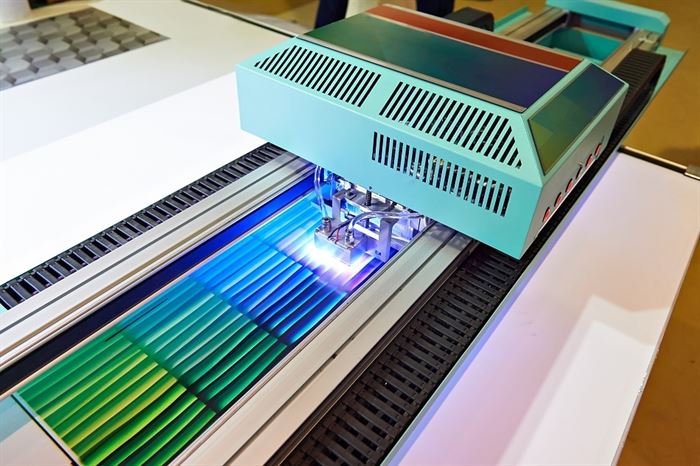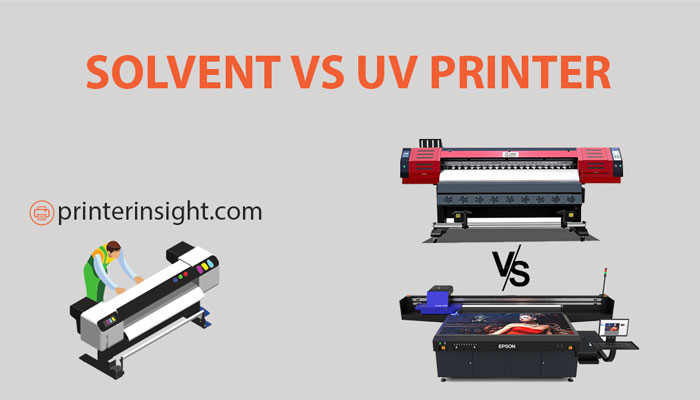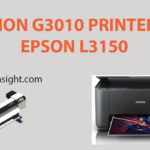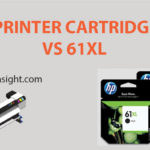Are you looking for a sustainable solution to improve the printing quality?
Then, you are familiar with the debate of “Solvent vs UV Printer.” These printers are highly applicable in commercial printings. It is difficult for you to choose a suitable one between these two concerning your demands.
But don’t worry. We are here for your convenience. This comparison guide will help you make a perfect decision to optimise your printing experience. Let’s make a move.

Solvent Ink Vs UV Ink
Solvent Ink
Using solvent ink is an easy way to handle printing. Here, solvent creates a chemical bond between the ink and the surface elements where you apply the printing. It involves water, pigment, resin, etc.
Resin elements act to improve the stickiness of the solvent ink. Besides, pigments include color variety in solvent-based printing.
But how do you cure solvent ink?
You have two viable options: evaporation and heating. Heating is more effective than evaporation of solvent inks.
This ink takes a little bit more time to dry. That’s why you need to use more ink compared to UV printers for the same quantity of prints. Nowadays, eco-solvent inks are popular among users dealing with small-scale printing.
UV Ink
UV (Ultraviolet) ink gets cured through LED UV lamps. This kind of ink becomes dry only under ultraviolet rays. So, it doesn’t become too thick. The main ingredients of UV ink are Vitamin B-12, tonic water, etc.
UV ink’s USP (Unique Selling Point) is its nature-friendly characteristics. UV printing is greener technology than other printing options of modern times. It also sustains for an extended period.
Besides, you don’t find any association of Volatile Organic Compounds in this case. That’s why UV ink gets disposed of quickly. It adds high-quality gloss to the printed photos. You can check this video about “Best Printer With Long Lasting ink”
UV inks are worthwhile for outdoor graphics. But you don’t require lamination to optimize this printing.
Moreover, the toughness and resistance to scratch make it dependable for a wide variety of printing. If you search for the reliable printer ink for your complex projects, you can rely on UV ink.
What Is UV Printer?
UV printers are widely used in large-scale printing in commercial sectors. This type of printer is an upgraded version of eco-solvent flatbed printers. They use UV technology for printing documents, photos, etc.
UV printers consist of an LED UV lamp and a cooling mechanism. These highly functional and durable printers are compatible with eco-solvent ink, edible ink, textile ink, along with UV ink.

There is no need for ventilation during UV printing because of the solvent-free nature. Here, printers incorporate LED UV bulbs to improve print quality.
It is an excellent advantage for the users. They can print documents in a versatile atmosphere in open and closed zones.
UV ink-based printing is almost harmless for the users. They are free from toxicity during printing. That’s why regular printer users prefer UV printers to other kinds of printers.
Solvent Printers
Unlike UV printers, solvent printers function through solvent-based technology. Here, printers use liquid ink, which is usually a mixture of solvent and pigment.
After proper mixing, this liquid ink goes through an evaporation process. It is necessary to produce a hard layer of ink usable for solvent printers.
Usually, solvent printers produce flying solvent. This is not good for the health of operators. These printers fall behind other printers due to the hazardous nature of printing.
Now, you need to have a clear concept of factors that affect the mechanisms used in solvent and UV printings. Then, it will be easier for you to decide, won’t it?
Factors That Will Affect Your Choice:
You have to find the answers to some vital questions before choosing between solvent and UV printers. Such as
- How Long Does The Printer Sustain?
- Is The Printer Sound In The Case Of Environmental effectiveness?
- In Which Purpose Will You Use The Printer?
- What Is The Average Productivity Of A Printer?
- Is It Cost-effective?
- Does The Printer Support Versatility In Printing?
- Is The Printer Compatible With Both Indoor And Outdoor Printing?
- Do Your Printers Allow Mounting Prints On Rigid Objects?
- Is It Easy To Handle And Safe?
- What Is Your Required Print Speed?
- Can The Printer Deliver High-quality Printing?
Does it seem difficult?
Relax.
You need to get detailed information about UV and solvent printers. Then, you can conveniently answer these questions and make your choice.
Head-to-head Comparisons Of Solvent Vs UV Printers
| Topic | UV Printer | Solvent Printer |
| Printing Mechanism | UV curing Technologywith cooling mechanism and LED lamps. | Solvent-based technology with coating spray on the object’s surface. |
| Ink | UV ink | Solvent or eco-solvent ink |
| Color Compatibility | 5 types of colors | 6-8 types of colors |
| Drying Process | Instant drying of printings due to reacting with LED ultraviolet bulbs. | It takes 2-3 extra hours to dry under room temperatures. |
| Usability | Commercial printings, double-sided window graphics, fancyworks, fabrics, transformative signages, etc. | It is not supportive of embroidery printing. It is OK with textiles, bottles, etc. |
| Durability | 2-3 years. Scratchproof to a large extent. | 1-2 years. Scratchproof. |
| Cost Of Ink | Cost-effective (around $90 dollars/L) | Low-cost. (around $60 per litre) |
| Thermal Efficiency | Excellent | OK for normal temperatures. |
| List of products | Amazon | Amazon |
Pros And Cons Of Solvent Printers
Pros
- Economical
- Worthwhile for short-term printing applications.
- Vibrant color makes it effective for outdoor use.
- Scratchproof
- Impressive print quality
- Resistant to excessive water flow and heat.
Cons
- It is not eco-friendly.
- Emission of VOCs (Volatile Organic Compounds).
- Excessive use of ink.
- It requires lamination for high durability.
- It is not supportive of rapid drying of ink.
Pros and Cons Of UV Printers
Pros
- These printers are eco-friendly.
- No emission of VOCs.
- Energy-saving technology.
- It ensures minimal use of UV inks during high-volume printing.
- UV printing is solvent-free. So, you don’t need to be worried about ventilation.
- UV printers ensure quick drying of UV ink. That’s why you can perform the post-printing operations smoothly.
- These printers are compatible with versatile materials like paper, plastic, wooden, metal, and fabric substances.
- There is no chance of spreading ink because of instant drying.
- UV printing is highly durable.
- Improved detailing.
- Applicable in both outdoor and indoor.
- This kind of printing is comparatively less vulnerable to scratch and fading.
- Easy to handle and transport.
- Print quality is outstanding.
- Wide range of color variations.
- Safe technology for printing high-volume printing.
Cons
- UV printing is a little bit more expensive than solvent printing.
- Usually, this printer doesn’t support glossy papers. But you can include high-class gloss by using clear UV ink.
Now you know about solvent and UV printers in detail. Let’s have a look at some crucial FAQs related to this topic.
FAQs
- What Is The Difference Between Eco-Solvent And Digital UV Printing?
The main difference between these two types of printers is ink.
Digital UV printers use powdered UV inks. Here, the printed images are both convex and concave.
On the contrary, Eco-solvent printers use a spot of solvent ink that is weaker and more delicate. These printers are not supportive of white ink. This feature limits their application in many cases.
- Is UV Printing Same As Sublimation?
UV printing is similar to sublimation in many aspects. There is no need for color lamination in both cases.
These two also have some differences. UV printing is compatible with almost all kinds of materials. But sublimation is applicable in polyester and rigid materials like mugs.
Besides, UV printing is very time-saving. It allows quick drying of UV inks. On the other hand, image transfer is critical during sublimation.
Moreover, sublimation is not as eco-friendly as UV printing. That’s why users prefer UV printing in most cases.
- Is An Inkjet Printer A Solvent Printer?
Yes. An inkjet printer is a solvent printer. Solvent-based inkjet printers are effective for printing on large-scale signages.
- How Long Does UV Printing Last?
UV printing doesn’t fade for almost 2-3 years outdoors without lamination. After proper lamination, this type of printing lasts for 4-5 years. Its shelf life varies due to the handling process and environmental issues.
- Is Epson Ecotank a Solvent Printer?
Yes. Epson Ecotank is a solvent printer. It uses eco-solvent ink for printing.
Final Words
In this “Solvent Vs UV Printer” comparison guide, you have learned all minute details about these printers. So, what should be your choice?
If you prefer ecological effectiveness in printing, you should go for UV printers without any doubt. Ultraviolet ink-based printers deliver more durable and reliable prints compared to solvent printers.
We hope this guide will help you to make your decision correctly. Stay tuned to get more information about modern printing technologies.
Happy printing.




